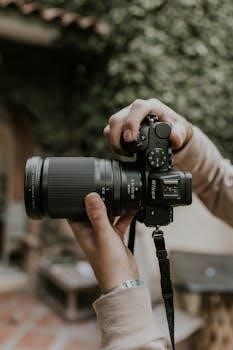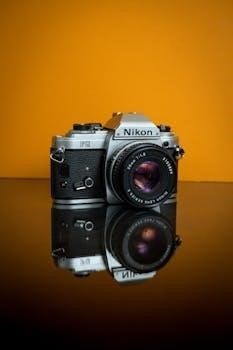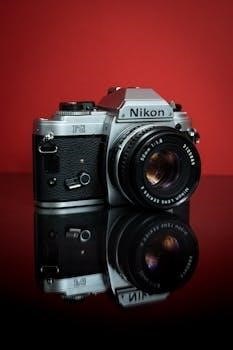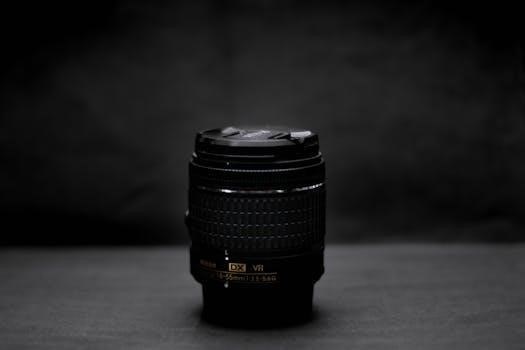Nikon F2 Manual⁚ A Comprehensive Guide
This comprehensive guide delves into the intricacies of the Nikon F2, a celebrated camera in the realm of film photography. Covering everything from basic operation to advanced techniques, this manual aims to provide users with the knowledge to fully exploit the F2’s capabilities.
The Nikon F2, a successor to the iconic Nikon F, represents a pinnacle of mechanical camera design, solidifying its place as a workhorse for professional photographers. Introduced in the early 1970s, the F2 built upon the F’s strengths while incorporating significant improvements in terms of features and ergonomics. This camera gained renown for its robustness, reliability, and versatility, making it a favorite among photojournalists and serious hobbyists alike.
The F2 boasts a fully mechanical shutter, allowing it to operate independently of battery power, a crucial advantage in challenging environments. Its interchangeable viewfinder system, coupled with a vast array of Nikkor lenses, provided unparalleled flexibility for various photographic applications. Furthermore, the F2’s advanced metering options, particularly with the Photomic finders, offered precise exposure control.
This manual serves as a detailed guide to understanding and utilizing the Nikon F2’s features. Whether you’re a seasoned film photographer or a newcomer to the world of classic cameras, this manual will equip you with the knowledge to master the F2 and unlock its full potential. Embark on a journey to rediscover the art of photography with this timeless camera.
Key Features of the Nikon F2
The Nikon F2 is renowned for a range of key features that set it apart as a top-tier professional camera. One of its defining characteristics is its robust, all-mechanical design, ensuring reliable operation even without battery power for shutter functions. This made it a dependable tool for photographers in diverse and demanding environments.
The F2’s interchangeable viewfinder system offers exceptional versatility. Users can swap finders to suit different shooting scenarios, from waist-level finders for discreet photography to metered prisms for accurate exposure readings. The camera also boasts a wide range of shutter speeds, from bulb to 1/2000th of a second, providing extensive creative control over motion blur and depth of field.
Another notable feature is its compatibility with a vast selection of Nikkor lenses, renowned for their sharpness and optical quality. The F2 also includes a mirror lock-up function, minimizing vibrations for sharper images, especially in macro or long-exposure photography. With its combination of durability, versatility, and a wealth of accessories, the Nikon F2 remains a highly sought-after camera among film enthusiasts.
Loading Film into the Nikon F2
Loading film into the Nikon F2 is a straightforward process, ensuring a secure and reliable experience. Begin by opening the camera back, achieved by rotating the O/C key counterclockwise until the arrow aligns with the “O” mark. This will release the hinged camera back, allowing access to the film chamber.
Insert the film cartridge into the left side of the camera, pushing it in until it sits securely. Next, pull the film leader across the film plane and insert it into one of the slots on the take-up spool. Advance the film using the film advance lever, ensuring that the sprocket teeth engage with the perforations on both sides of the film.
Continue advancing the film until the frame counter reaches “1.” Close the camera back, making sure it clicks securely into place. Then, advance the film two more times to move past the exposed leader. The camera is now loaded and ready for shooting. Remember to set the ISO on your meter, if applicable.
Unloading Film from the Nikon F2
Once you’ve finished shooting a roll of film, unloading it from your Nikon F2 is simple. After the last exposure, continue advancing the film until the film advance lever stops. Do not force it. This indicates that the film is fully wound onto the take-up spool.
To rewind the film, locate the rewind knob on the top left of the camera. Flip out the rewind crank and turn it in the direction indicated by the arrow, usually clockwise. You’ll feel resistance initially, but as the film detaches from the take-up spool, the tension will decrease.
Continue rewinding until you feel a sudden release, indicating that the film leader has completely disengaged from the take-up spool and is fully inside the cartridge. Open the camera back by rotating the O/C key. Gently remove the film cartridge and take it to your local photo lab for processing or develop it yourself. Be sure to keep the film in a cool, dry place until development.
Using the Nikon F2 Photomic Finder
The Nikon F2 Photomic finder is an interchangeable viewfinder head that integrates a built-in light meter, assisting in achieving optimal exposure. To use it effectively, first ensure the meter is activated. This usually involves installing batteries and confirming they are correctly oriented.
Once powered, the Photomic finder displays metering information within the viewfinder. Typically, this includes a needle or LED display indicating the suggested aperture based on the selected shutter speed, or vice versa. Adjust either the aperture ring on the lens or the shutter speed dial on the camera body until the needle aligns with the center mark or the LEDs indicate a correct exposure.

Pay attention to the metering pattern of your specific Photomic finder variant. Some offer center-weighted metering, while others may provide spot metering. Understanding the metering pattern allows you to accurately assess the light in your scene and make informed exposure decisions. Always double-check your settings, especially in challenging lighting conditions, to ensure well-exposed photographs. Remember to consult your specific finder’s manual for detailed instructions.
Understanding Shutter Speed and Aperture Settings
Mastering shutter speed and aperture is crucial for achieving desired effects with the Nikon F2. Shutter speed, measured in seconds or fractions thereof, determines the duration the camera’s sensor is exposed to light. Faster shutter speeds (e.g., 1/500s) freeze motion, ideal for capturing fast-moving subjects. Slower shutter speeds (e.g., 1/30s) allow more light in, useful in low-light situations, and can create motion blur.
Aperture, denoted as an f-number (e.g., f/2.8, f/16), controls the size of the lens opening. A wider aperture (smaller f-number like f/2.8) lets in more light, creating a shallow depth of field, blurring the background and isolating the subject. A narrower aperture (larger f-number like f/16) allows less light in, resulting in a greater depth of field, keeping more of the scene in focus.
The interplay between shutter speed and aperture dictates the overall exposure. Adjusting one necessitates compensating with the other to maintain proper brightness. Experiment with various combinations to understand their impact on your images and achieve the desired creative outcome.
Flash Synchronization with the Nikon F2
The Nikon F2 boasts impressive flash synchronization capabilities, allowing photographers to illuminate their subjects effectively in various lighting conditions. Understanding how to properly sync your flash with the camera is crucial for achieving well-exposed and balanced images. The F2 is designed to synchronize with various types of flashbulbs at almost all shutter speeds.
The F2 synchronizes with electronic flashes at speeds up to 1/80 of a second. This synchronization speed is vital, as using faster shutter speeds can result in only part of the image being exposed by the flash, leading to a dark band in the frame. To ensure proper synchronization, set your shutter speed to 1/80s or slower when using electronic flashes.
Consult your flash unit’s manual for specific recommendations regarding power settings and optimal distances. Experimenting with different flash settings and distances will help you achieve the desired lighting effect.
By mastering flash synchronization with your Nikon F2, you can expand your photographic possibilities and capture stunning images in challenging lighting scenarios.
Using the Self-Timer
The Nikon F2 features a self-timer, a valuable tool for capturing self-portraits or group shots where the photographer wishes to be included; The self-timer allows you to set a delay before the shutter is released, providing ample time to position yourself within the frame.
To activate the self-timer, locate the self-timer lever on the front of the camera. Rotate the lever to the desired delay time, typically ranging from a few seconds up to ten seconds. Once the lever is set, fully depress the shutter release button. The self-timer mechanism will engage, and the shutter will be released after the set delay.
Before using the self-timer, ensure that your camera is securely mounted on a tripod or stable surface to prevent camera shake and blurry images. Carefully compose your shot and pre-focus on the desired area before activating the timer. This ensures that the final image is sharp and well-composed.
Experiment with different delay times to find what works best for your needs. The self-timer is a versatile feature that enhances the usability of your Nikon F2.
Accessories for the Nikon F2
The Nikon F2 boasts a rich ecosystem of accessories that expand its functionality and versatility. The availability of these accessories allowed photographers to tailor their camera to specific needs and shooting scenarios.

One notable accessory is the extensive range of Nikkor lenses. Nikon offered a wide selection of lenses, from wide-angle to telephoto, catering to various photographic styles. Motor drives, such as the MD-2, enabled rapid film advance for action photography.
Various viewfinders were available, including the Photomic finders that offered built-in light metering. These finders provided different metering modes, such as center-weighted and spot metering, enhancing exposure accuracy. The Speedlight flash units, designed for Nikon cameras, provided reliable flash synchronization.
Close-up photography accessories included extension tubes and bellows, allowing for macro shots. Cases and straps offered protection and convenience for carrying the camera. These accessories, among others, transformed the Nikon F2 into a highly adaptable system.
The DS-12 allowed the user to concentrate.
Troubleshooting Common Issues
Even with its robust design, the Nikon F2 can occasionally encounter issues. Addressing these problems effectively ensures the camera’s continued operation and longevity. One common issue is film loading difficulties. Ensure the film leader is properly inserted and the film sprockets are engaged correctly.
If the shutter fails to fire, check the battery if using a Photomic finder, as it powers the metering system and can affect shutter release. Also, verify that the multiple exposure lever is not engaged unintentionally. Metering inaccuracies can arise from dirty viewfinder contacts or a faulty meter cell.

Cleaning the contacts and replacing the battery are potential solutions. Another problem is a sticky or slow shutter, often due to old lubricants. A CLA (Clean, Lube, and Adjust) by a qualified technician is recommended. Light leaks can occur from deteriorated light seals.
Replacing the seals is essential to prevent fogging of the film. Finally, a jammed film advance lever might indicate a film jam or a mechanical issue requiring professional repair. By systematically addressing these common issues, users can maintain their Nikon F2 in optimal condition.
Battery Installation and Replacement
The Nikon F2, particularly when equipped with a Photomic finder, relies on batteries for its light metering system. Proper battery installation and timely replacement are crucial for accurate exposure readings. The F2 typically utilizes silver oxide batteries (SR44 or equivalent) readily available.
To install the batteries, locate the battery chamber, usually found on the base of the camera or within the Photomic finder itself. Using a coin or appropriate tool, unscrew the battery chamber cap. Note the polarity markings inside the chamber. Insert the batteries according to the indicated positive (+) and negative (-) orientations.
Ensure the batteries make good contact with the terminals. Securely tighten the battery chamber cap. To check battery power, observe the meter needle in the viewfinder when the meter is activated. A weak or non-existent reading suggests the batteries need replacement.
Always remove old batteries promptly to prevent corrosion, which can damage the camera’s internal components. When replacing batteries, it’s advisable to replace all batteries at the same time to ensure consistent power output. Proper battery maintenance guarantees reliable metering and optimal performance from your Nikon F2.
Nikon F2⁚ User Experience and Tips
The Nikon F2 offers a classic film photography experience, blending robust mechanical construction with intuitive controls. Users often praise its durability and reliability, making it a favorite for both enthusiasts and professionals. The F2’s fully mechanical operation allows shooting even without batteries (except for metering with Photomic finders).

A key tip for new users is to familiarize themselves with the film loading process. Ensure the film leader is properly engaged with the take-up spool to avoid mid-roll mishaps. Practice adjusting shutter speed and aperture settings to understand their impact on exposure.
Experiment with different lenses to explore creative possibilities. The Nikon F2 system boasts a wide range of Nikkor lenses known for their sharpness and optical quality. Pay attention to focusing accuracy, especially when using fast aperture lenses.
Consider using an external light meter for challenging lighting situations or when the built-in meter’s accuracy is questionable. Regular cleaning of the lens and body is crucial to maintain optimal performance. Embrace the learning curve and enjoy the tactile experience of shooting with this iconic camera.
Maintenance and Care for the Nikon F2
Proper maintenance is crucial for preserving the longevity and performance of your Nikon F2. Regularly clean the camera body with a soft, dry cloth to remove dust and fingerprints. Avoid using harsh chemicals or abrasive materials that could damage the finish.
The lens elements should be cleaned with a specialized lens cleaning solution and microfiber cloth. Gently wipe the lens in a circular motion, starting from the center and moving outwards. Store the camera in a cool, dry place, away from direct sunlight and humidity.
Periodically check the light seals around the film door and replace them if they become brittle or worn. Faulty light seals can cause light leaks, affecting the quality of your images. The mirror and focusing screen should be cleaned with a blower brush to remove dust particles.
If you encounter any mechanical issues, consult a qualified camera technician for repairs. Avoid attempting to disassemble the camera yourself, as this could cause further damage. With proper care and maintenance, your Nikon F2 will continue to provide years of reliable service. Remember to handle it with care and appreciate its craftsmanship.
